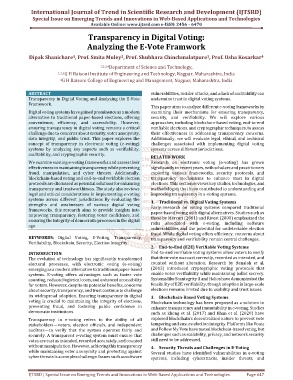Page 657 - Emerging Trends and Innovations in Web-Based Applications and Technologies
P. 657
International Journal of Trend in Scientific Research and Development (IJTSRD)
Special Issue on Emerging Trends and Innovations in Web-Based Applications and Technologies
Available Online: www.ijtsrd.com e-ISSN: 2456 – 6470
Transparency in Digital Voting:
Analyzing the E-Vote Framwork
3
1
Dipak Shanichare , Prof. Smita Muley , Prof. Shubhara Chinchmalatpure , Prof. Usha Kosarkar
2
4
1,2,3,4 Department of Science and Technology,
1,2,3 G H Raisoni Institute of Engineering and Technology, Nagpur, Maharashtra, India
4 G H Raisoni College of Engineering and Management, Nagpur, Maharashtra, India
ABSTRACT vulnerabilities, insider attacks, and a lack of auditability can
Transparency in Digital Voting and Analyzing the E-Vote undermine trust in digital voting systems.
Framework.
This paper aims to analyze different e-voting frameworks by
Digital voting systems have gained prominence as a modern examining their mechanisms for ensuring transparency,
alternative to traditional paper-based elections, offering security, and verifiability. We will explore various
convenience, efficiency, and accessibility. However, approaches, including blockchain-based voting, end-to-end
ensuring transparency in digital voting remains a critical verifiable elections, and cryptographic techniques, to assess
challenge due to concerns about security, voter anonymity, their effectiveness in addressing transparency concerns.
data integrity, and public trust. This paper explores the Additionally, we will evaluate legal, ethical, and technical
concept of transparency in electronic voting (e-voting) challenges associated with implementing digital voting
systems by analyzing key aspects such as verifiability, systems across different jurisdictions.
auditability, and cryptographic security.
RELATED WORK
We examine existing e-voting frameworks and assess their Research on electronic voting (e-voting) has grown
effectiveness in maintaining transparency while preventing significantly in recent years, with scholars and practitioners
fraud, manipulation, and cyber threats. Additionally, exploring various frameworks, security protocols, and
blockchain-based voting and end-to-end verifiable election transparency mechanisms to enhance trust in digital
protocols are discussed as potential solutions for enhancing elections. This section reviews key studies, technologies, and
transparency and trustworthiness. The study also reviews methodologies that have contributed to understanding and
legal and ethical considerations in implementing e-voting improving transparency in e-voting systems.
systems across different jurisdictions By evaluating the
1. Traditional vs. Digital Voting Systems
strengths and weaknesses of various digital voting Early research on voting systems compared traditional
frameworks, this research aims to provide insights into paper-based voting with digital alternatives. Studies such as
improving transparency, fostering voter confidence, and those by Mercuri (2001) and Rivest (2008) emphasized the
ensuring the integrity of democratic processes in the digital risks associated with e-voting, including software
age.
vulnerabilities and the potential for undetectable election
fraud. While digital voting offers efficiency, concerns about
KEYWORDS: Digital Voting, E-Voting, Transparency, transparency and verifiability remain central challenges.
Verifiability, Blockchain, Security, Election Integrity
2. End-to-End (E2E) Verifiable Voting Systems
INTRODUCTION End-to-end verifiable voting systems allow voters to verify
The evolution of technology has significantly transformed that their vote was cast correctly, recorded as intended, and
electoral processes, with electronic voting (e-voting) counted without alteration. Research by Benaloh et al.
emerging as a modern alternative to traditional paper-based (2013) introduced cryptographic voting protocols that
systems. E-voting offers advantages such as faster vote enable voter verifiability while maintaining ballot secrecy.
counting, reduced logistical costs, and enhanced accessibility Systems like Scantegrity II and Helios have demonstrated the
for voters. However, despite its potential benefits, concerns feasibility of E2E verifiability, though adoption in large-scale
about security, transparency, and trust continue to challenge elections remains limited due to usability and trust issues.
its widespread adoption. Ensuring transparency in digital
3. Blockchain-Based Voting Systems
voting is crucial to maintaining the integrity of elections,
Blockchain technology has been proposed as a solution to
preventing fraud, and fostering public confidence in enhance transparency and immutability in e-voting. Studies
democratic institutions. such as Zheng et al. (2017) and Khan et al. (2020) have
Transparency in e-voting refers to the ability of all explored blockchain's decentralized nature to prevent vote
stakeholders—voters, election officials, and independent tampering and ensure election integrity. Platforms like Voatz
auditors—to verify that the system operates fairly and and Follow My Vote have tested blockchain-based voting, but
securely. A transparent e-voting system must ensure that challenges such as scalability, privacy, and network security
votes are cast as intended, recorded accurately, and counted still need to be addressed.
without manipulation. However, achieving this transparency
4. Security Threats and Challenges in E-Voting
while maintaining voter anonymity and protecting against
Several studies have identified vulnerabilities in e-voting
cyber threats is a complex challenge. Issues such as software
systems, including cyberattacks, insider threats, and
IJTSRD | Special Issue on Emerging Trends and Innovations in Web-Based Applications and Technologies Page 647

